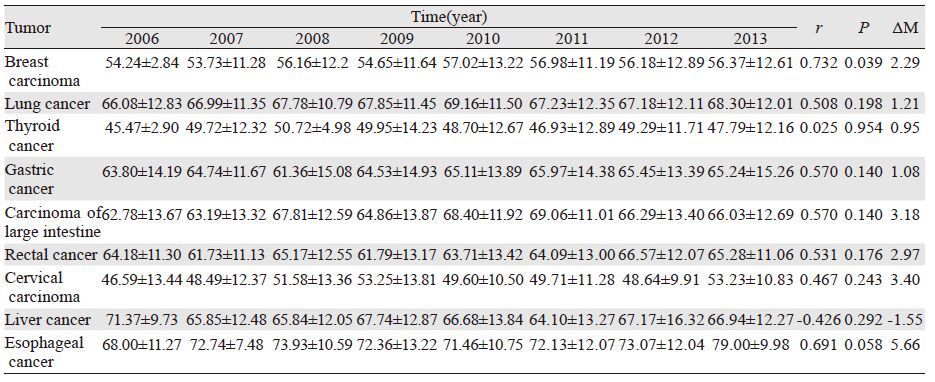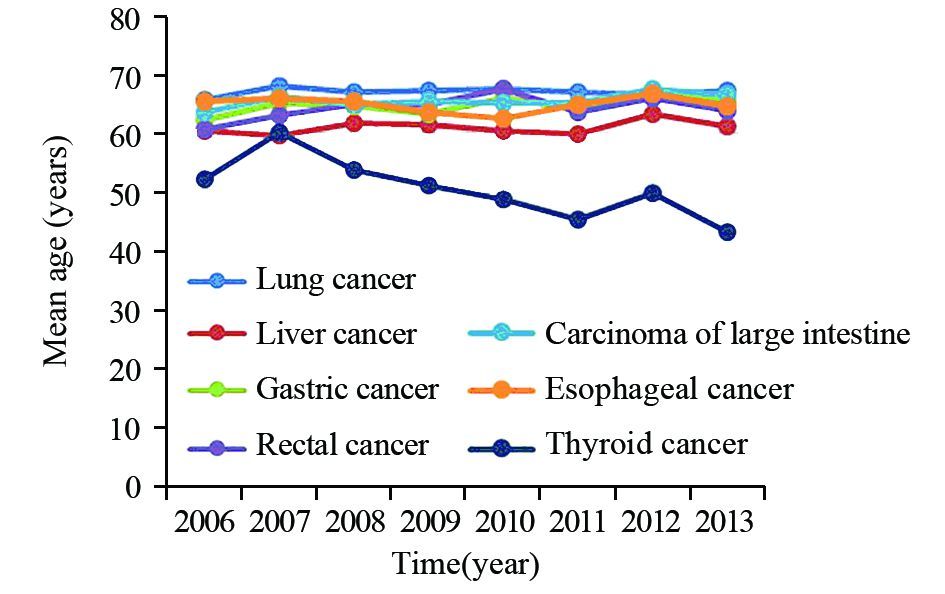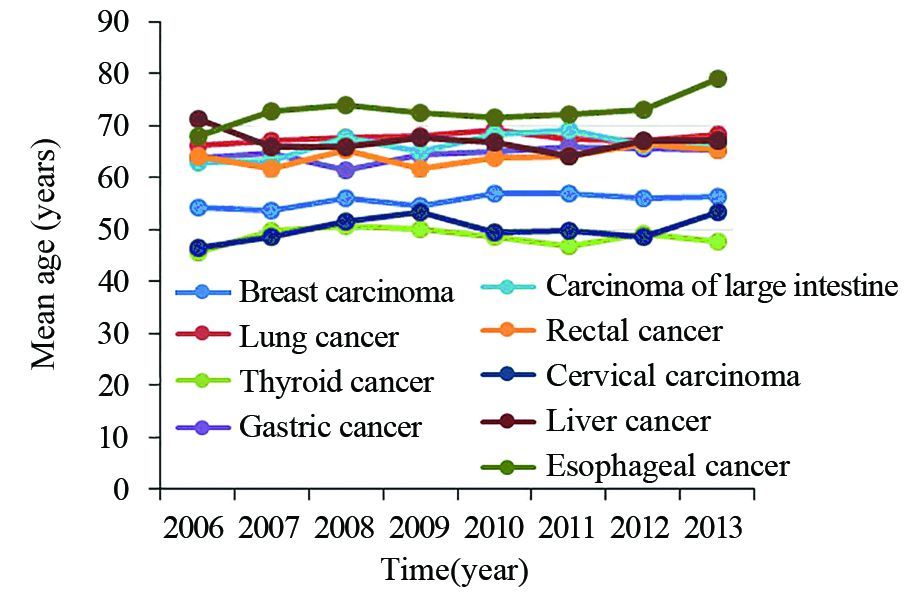文章信息
- 武汉市江岸区2006—2013年肿瘤流行状况分析
- Tumor Prevalence in Jiang'an District of Wuhan from 2006 to 2013
- 肿瘤防治研究, 2016, 43(9): 796-800
- Cancer Research on Prevention and Treatment, 2016, 43(9): 796-800
- http://www.zlfzyj.com/CN/10.3971/j.issn.1000-8578.2016.09.014
- 收稿日期: 2016-01-08
- 修回日期: 2016-05-04
2. 430071 武汉, 武汉大学公共卫生学院流行病与卫生统计学系;
3. 430014 武汉, 武汉市江岸区疾病预防控制中心
2. Department of Epidemiology and Health Statistics, School of Public Health, Wuhan University, Wuhan 430071, China;
3. Jiang'an Center for Disease Control and Prevention of Wuhan City, Wuhan 430014, China
随着工业化和城市化的发展,人口老龄化以及人们生活方式的不断改变,恶性肿瘤已经成为发达国家和许多发展中国家人口死亡的主要原因之一[1]。据估计,2010年仅我国死于恶性肿瘤的人数就占全球27%,2030年世界将有超过1 100万人死于恶性肿瘤[2]。由于人们对恶性肿瘤关注的不断增加,了解恶性肿瘤的发病状况及流行趋势亦显得尤为重要。本研究利用2006—2013年武汉市江岸区恶性肿瘤登记报告资料来分析该区恶性肿瘤的发病趋势,评价恶性肿瘤对城区居民健康的影响,旨在为肿瘤防治策略和措施的制定提供科学依据。
1 资料与方法 1.1 资料来源资料来源于武汉市江岸区疾病预防控制中心慢性病防治科2006—2013年的发病数据登记。2006年1月1日—2013年12月31日的全部肿瘤发病报告,人口资料来源于公安系统各年度人口统计报表。
患者的临床诊断在一级及以上医院怀疑,二级及以上医院怀疑取样基础上,最终均经三级及以上医院的病理学诊断为准,肿瘤的分类严格按照国际疾病分类第10版(ICD-10)对恶性肿瘤(包括脑肿瘤)数据进行统一编码并分类整理建库。
1.2 研究方法 1.2.1 年度变化百分比(annual percentage change,APC)率的时间序列分析选用对数刻度来表示其相对变化的程度,构建ln(r)=α+βx+c线性模型,对肿瘤发病率进行回归。其中,r表示标化率,X表示年份,α为常数项,β为回归系数,c为随机误差项。利用回归系数β计算APC,如下所示:APC=100×(eβ-1)。
1.2.2 平均发病年龄差(ΔM)以各病每年的平均发病年龄(M)与时间序列进行Pearson相关分析(用每年病例数加权),差异有统计学意义后,计算统计量平均发病年龄差(ΔM),ΔM = M(n,n-1) -M(1,2) ,n指年份。
1.3 统计学方法运用2010年全国标准人口构成分别对恶性肿瘤性别(男、女)发病率、年龄组发病专率、年龄调整发病率等统计指标进行标化,所有数据均采用Excel建立数据库,并利用SPSS17.0统计软件包进行统计分析,统计学检验水准α=0.05。
2 结果 2.1 发病构成情况2006—2013年间该区共报告恶性肿瘤新发病例17 779例,男女比例为1.12:1。从男、女性主要恶性肿瘤发病构成图可以看出:男性发病居前5位的依次为肺癌、肝癌、胃癌、大肠癌、直肠癌,女性发病居前5位的依次为乳腺癌、肺癌、甲状腺癌、胃癌、大肠癌,见图 1~2。

|
| 图 1 2006—2013年武汉市江岸区男性主要恶性肿瘤发病构成 图 22006—2013年武汉市江岸区女性主要恶性肿瘤发病构成 Figure 1 Constitution of major malignant tumors in Jiang'an District of Wuhan,2006-2013 (Male) Figure 2Constitution of major malignant tumors in Jiang'an District of Wuhan,2006-2013 (Female) |
武汉市江岸区2006—2013年主要恶性肿瘤标化发病率有升有降,其中男性甲状腺恶性肿瘤APC为34.58%(P<0.001)有统计学意义,女性甲状腺恶性肿瘤APC为35.93%(P<0.001)、宫颈癌APC为8.65%(P=0.004)有统计学意义,见表 1~2。

|

|
通过对武汉市江岸区2006—2013年主要恶性肿瘤平均发病年龄进行统计学分析可知,男性甲状腺恶性肿瘤与时间呈负相关(r=-0.801,P=0.017),平均发病年龄8年间提前了9.75岁,女性乳腺癌与时间呈正相关(r=0.732,P=0.039),平均发病年龄8年间延后了2.29岁,见表 3~4,图 3~4。

|

|

|
| 图 3 男性主要恶性肿瘤随时间的平均发病年龄分布情况 Figure 3 Average onset age distribution of malignant tumors in male |

|
| 图 4 女性主要恶性肿瘤随时间的平均发病年龄分布情况 Figure 4 Average onset age distribution of malignant tumors in male |
武汉市由江岸区、江汉区、硚口区、汉阳区、武昌区、洪山区以及青山区共7个中心城区构成,是我国七大中心城市之一,人口达1 033.80万(2014年)[3]。其中江岸区位于武汉市中心位置,是武汉市的政治、经济、信息和文化中心,也是武汉市商业最为发达的地区之一。该区总人口788 609人(2014年)[3],且居民以武汉本地人为主,居民居住密度高、生活环境相似,由于城市化、工业化进程加快使得环境污染日趋严重,加之城区人们有些不良的生活方式使得恶性肿瘤发病不断增加[4],因此,及时准确地掌握江岸区恶性肿瘤发病的流行状况,可以为以大城市居民为对象的区域性疾病防控工作的开展和政策制定,降低居民疾病负担提供有效的参考[5]。
本研究发现武汉市江岸区男女恶性肿瘤发病顺位明显不同;男性甲状腺恶性肿瘤发病率呈现上升趋势,而女性甲状腺恶性肿瘤和宫颈癌都呈现上升趋势,且女性甲状腺恶性肿瘤的发病率远高于男性;男性甲状腺恶性肿瘤与时间呈负相关,女性乳腺癌与时间呈正相关。
武汉市江岸区2006年至2013年恶性肿瘤发病监测数据资料显示,新发病例男女性别比为1.12:1。男女总发病顺位前5位是肺癌、乳腺癌、肝癌、胃癌和大肠癌,与武汉市上世纪90年代发病顺位[6]相比,乳腺癌从第5位跃居第2位,胃癌从第2位退居第4位,甲状腺恶性肿瘤从10名以外跃居第7位。男性发病顺位依次为肺癌、肝癌、胃癌、大肠癌、直肠癌,女性发病顺位依次为乳腺癌、肺癌、甲状腺癌、胃癌、大肠癌。与中国肿瘤登记2010年数据[7]相比,武汉市江岸区的发病顺序甲状腺恶性肿瘤靠前,食管癌靠后。伴随生产力的发展,生活水平的提高,环境质量的下降,武汉市江岸区恶性肿瘤发病顺位发生了较大变化。这种影响从某种程度上反映了恶性肿瘤环境致病因子的消长及生活方式变化的长期效应。
同时,武汉市江岸区男女性甲状腺恶性肿瘤发病率均呈现上升趋势,年平均增长速度分别为34.58%和35.93%;钱碧云等[8]在天津市的研究也提示男女性甲状腺恶性肿瘤的发病率呈现上升趋势,年平均增长速度分别为1.7%和3.1%。目前诸多观点倾向于影像学技术的进步及广泛应用、检查技术水平的提高、医疗资源的可及性及公众防癌意识的提高等导致了近年甲状腺癌的“高发”[9]。同时,武汉市江岸区女性宫颈癌发病率也呈现上升趋势,年平均增长速度为8.65%,温金锁等[10]在宝鸡市的研究也提示女性宫颈癌发病率呈现上升趋势,年平均增长速度为63.39%,可能与2010年武汉市在江岸区开展了乳腺癌和宫颈癌普查有关,故发病率上升趋势明显。
本研究还显示,女性甲状腺恶性肿瘤发病率明显高于男性。杨雷等[11]2013年基于全国肿瘤登记处数据的研究和Cohen等[12]在阿根廷的研究也发现女性甲状腺恶性肿瘤发病率更高。目前普遍认为可能与女性雌激素水平高有关[12]。
武汉市江岸区2006—2013年主要恶性肿瘤平均发病年龄的分析结果发现,男性甲状腺恶性肿瘤与时间呈负相关,平均发病年龄提前了9.75岁,女性乳腺癌与时间呈正相关,平均发病年龄延后了2.29岁。提示女性乳腺癌的防治工作取得了一定的效果,但是男性甲状腺恶性肿瘤对男性生命和健康的危害在加重,应重点防治。
综上所述,武汉市江岸区2006—2013年男女性恶性肿瘤的发病顺位明显不同,甲状腺恶性肿瘤的发病顺位提前;男女性甲状腺恶性肿瘤、女性宫颈癌发病率均呈现上升趋势,且男性甲状腺恶性肿瘤的发病时间提前;提示男女性的甲状腺恶性肿瘤和女性宫颈癌应该成为该区未来恶性肿瘤防制工作的重点。
| [1] | World Health Organization. The Global Burden of Disease: 2004 Update[M]. Geneva: World Health Organization, 2008 : 6 -7. |
| [2] | "Institute for Health Metrics and Evaluation" [EB/OL]. [2014-09-26]. Available: http://www.healthdata.org/search-gbd-data?s=china. |
| [3] | Wuhan City Bureau of Statistics (NBS). Report of the national economic and social development in Wuhan, 2014[N]. The Yangtze River Daily. 2015-3-12(004). [ 武汉市统计局. 2014年武汉市国民经济和社会发展统计公报[N]. 长江日报, 2015-3-12(004). ] |
| [4] | Liu HY, Liu H, Wu JH, et al. Analysis on diet nutrition and health status of community residents[J]. Zhonghua Ji Bing Kong Zhi Za Zhi, 2008, 12 (5) : 437–40. [ 刘淮玉, 刘红, 吴建华, 等. 社区居民膳食营养与健康状况的调查分析[J]. 中华疾病控制杂志, 2008, 12 (5) : 437–40. ] |
| [5] | Li SG, Zhang XF, Pang LJ, et al. Disease Burden of Malignant Neoplasms in Cancer Registries Division of Xinjiang Production and Construction Crops in 2010[J]. Zhong Liu Fang Zhi Yan Jiu, 2015, 42 (10) : 1011–5. [ 李述刚, 张学飞, 庞丽娟, 等. 2010年新疆生产建设兵团肿瘤登记地区恶性肿瘤疾病负担研究[J]. 肿瘤防治研究, 2015, 42 (10) : 1011–5. ] |
| [6] | Xu GL, Feng ZM, Duan JJ, et al. An Analysis of Incidence of Malignancies in Wuhan from 1995 to 1997[J]. Zhongguo Zhong Liu, 2002, 11 (8) : 455–6. [ 徐桂兰, 奉兆民, 段纪俊, 等. 武汉市1995年~1997年恶性肿瘤发病分析[J]. 中国肿瘤, 2002, 11 (8) : 455–6. ] |
| [7] | Chen WQ, Zheng RT, Zeng HM, et al. Report of Cancer Incidence and Mortality in China, 2011[J]. Zhongguo Zhong Liu, 2015, 24 (1) : 1–9. [ 陈万青, 郑荣寿, 曾红梅, 等. 2011年中国恶性肿瘤发病和死亡分析[J]. 中国肿瘤, 2015, 24 (1) : 1–9. ] |
| [8] | Qian BY, He M, Gao M, et al. Thyroid cancer incidence in the city of Tianjin during 2002-2006 and its secular trend in recent 26 year[J]. Zhonghua Pu Tong Wai Ke Za Zhi, 2011, 26 (4) : 275–8. [ 钱碧云, 何敏, 高明, 等. 2002-2006年天津市甲状腺癌发病率与26年间长期趋势分析[J]. 中华普通外科杂志, 2011, 26 (4) : 275–8. ] |
| [9] | Davies L, Welch HG. Current thyroid cancer trends in the United States[J]. JAMA Otolaryngol Head Neck Surg, 2014, 140 (4) : 317–22. DOI:10.1001/jamaoto.2014.1 |
| [10] | Wen JS, Qi YQ, Yao LY, et al. Epidemic trend analysis of malignant tumor in Baoji City[J]. Zhonghua Ji Bing Kong Zhi Za Zhi, 2012, 16 (10) : 839–41. [ 温金锁, 戚玉琴, 姚乐毅, 等. 宝鸡市恶性肿瘤流行趋势分析[J]. 中华疾病控制杂志, 2012, 16 (10) : 839–41. ] |
| [11] | Yang L, Zheng RS, Wang N, et al. Analysis of incidence and mortality of thyroid cancer in China, 2010[J]. Zhonghua Yu Fang Yi Xue Za Zhi, 2014, 48 (8) : 663–8. [ 杨雷, 郑荣寿, 王宁, 等. 2010年中国甲状腺癌发病与死亡情况[J]. 中华预防医学杂志, 2014, 48 (8) : 663–8. ] |
| [12] | Cohen Sabban MA, Palmero C, Bertrand B, et al. Incidence rate of thyroid cancer in Neuquén(2001-2012)[J]. Endocrinol Nutr, 2014, 61 (9) : 455–9. DOI:10.1016/j.endonu.2014.04.005 |
 2016, Vol. 43
2016, Vol. 43


